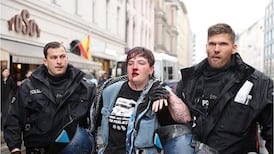This time last week there was a state of near hysteria following the senior team’s defeats to Armenia and a freshened-up Ukraine team.
The players and manager were probably under the most intense scrutiny and pressure of Stephen Kenny’s reign to date. They came out against Scotland with a ferocious fire and appetite to hush their critics.
They did it in some style too, scoring three goals in an accomplished performance on an evening that also saw them match the best competitive home result against a higher-ranked team since Ireland saw off Northern Ireland 3-0 in a World Cup qualifier in October 1989.
I was at that game in 1989 and remember it well. The Irish team under Jack Charlton were riding the crest of the wave after an incredible Euro ‘88 straight on to Italia ‘90.
READ MORE
They were great days. The best in my memory of Irish football. But, since 1994, they were heights Ireland just haven’t managed to replicate.
One thing struck me before the Scotland match and two things stood out for me in its aftermath.
Before the game a capacity crowd at the Aviva Stadium were vocal and determined in their support of the team and the manager. They had voted with their feet and turned up. There was no display of apathy or animosity; it really came across that the vibe was positive and supportive of this developing team.
And this was despite the fact the expectations of the team were not met in the games against Armenia and Ukraine.
Having been talked up as a group Ireland were aiming to win, there was a shook response to the Armenia defeat. It was perplexing in many respects after evident growth in performances leading up to that game. The heat in Yerevan was not really a factor. The players were fresh coming into the game.
Most problems seemed to stem from distancing between the lines, with large gaps visible between midfielders and the forwards. It was similar to what had been evident in games against Azerbaijan and Luxembourg.
The team just were not connected well enough, particularly in moments of transition, meaning the midfield of Cullen and Hendrick were unable to cover the necessary ground. You can correct that by only playing two forwards and having an attacking midfielder in between the two centre midfielders and the forwards or, you can just push your defensive line higher, so your midfielders are better connected and able to get pressure on the ball.
Against a team playing deep against you, you need the extra forwards to try to get between the lines but Ireland looked far too deep at times and exposed on quick transitions.
Against Scotland, the difference was immense. A change in personnel and shape was a factor. There was a level of tenacity and intent about Ireland right from the get-go.
Robust challenges were evident from the first minute, as they looked like a team out to prove something. And they did.
They proved they are a team capable of beating Scotland, and therefore should have been able to win the two previous games. It’s a bit of a conundrum. The distances between the units were much better against Scotland and also during Tuesday’s draw with Ukraine.
So what happened against Armenia and the first time against Ukraine?
In the aftermath of the Scotland game, the pendulum of opinion swung in an extreme way again, so all of a sudden Ireland veered from the wrong path to the right road again.
But it’s the hyping up of young players that concerns me. Troy Parrot was supposed to be the next Robbie Keane long before his experiences were ready for that level of expectation. He needed time to develop as a senior player before that potential could start to emerge at international level.
The same could be said of Chiedozie Ogbene and definitely, the emerging Nathan Collins is now in that category.
They need time and will make mistakes but the extreme reactions to the recent results and player performances lack balance and could be worrying if any of these young players go through a patch where things don’t fall perfectly for them.
Ireland have to win games, and the manager has set a higher bar of expectations but there needs to be a maturity about how we build up the young players. They need a bit of protection and time for their development and a little less of the extreme reactions.
What defines this Nations League campaign is where Ireland lie at the end of the September window. It won’t all be plain sailing, there will be highs and lows but consistency takes a bit of time. And requires plenty of patience.
Every now and then it’s important to zoom out and look at the bigger picture. The current process has been embraced by many stakeholders, but the currency of that process is time. Things will ebb and flow in the meantime, but looking at the bigger picture, there seems to be an exciting wave of talent learning to surf the stormy waters of international football.















